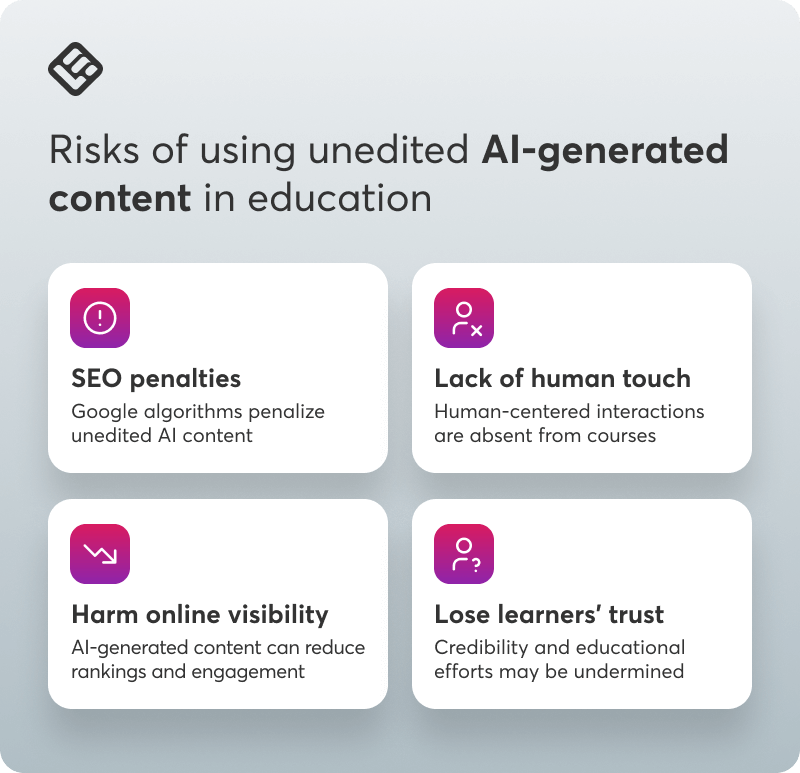Table of Contents
If you have been leaning on AI to write your content faster, while creating content in Learning Experience Platforms (LXPs) or online course platforms (e.g., LearnWorlds, Teachable, Thinkific, Kajabi), then you should keep reading.
Google has developed tools and algorithms that can detect unedited AI-generated content, placing purely AI-written text at high risk of serious SEO (search engine optimization) penalties. These penalties have led to an average 17.29% drop in traffic and reduced website visibility [1]. For course educators, this drop in traffic and visibility means fewer people finding your content, signing up, and paying you.
Recent studies [2] show that human writers create ads and human-like content that outperform AI-generated text as they achieve:
Additionally, SEO tests showed that 92% of human-written sites ranked better than their AI twins [3]. This number gap is one of the key reasons humanizing AI content has become such a priority for course creators in 2025.
What do these results mean, you ask? They mean that relying on AI-generated content can harm your online visibility, credibility, and overall educational efforts.
So, what is AI humanizing, and what does it include?
AI humanizing refers to the process of editing, refining, and adding depth to AI-generated material so it reads like it was written by a human person, not a tool. It’s not about rejecting AI, but about taking back control of your voice.
Are we stuck in an AI inception?
First, we started writing our own content, lesson by lesson, using our own tone and structure. Then AI came into education, and we handed over the keyboard. Now, in a strange twist, we’re asking other AI tools, like text converters and humanizers, to make that artificial intelligence text sound more… well, human.
It feels like something out of Inception: content written by us, rewritten by AI, then reworked again to pass as natural language.
But here’s the thing: Google can tell when content lacks actual human experience. That’s why humanized AI text performs way better than AI-generated content. One study that explored 1,000+ AI humanized articles [4] found that adding that “human” touch made a real difference:
These shifts confirm what many course creators are already feeling: learners notice the difference. They engage more with content that sounds like it came from someone who’s been where they are, not from a language model trained on billions of words.

So maybe it’s not about rejecting automation, but knowing how and where to use it. Not letting AI run the entire course, but letting it support the writing process without erasing your voice.
As our in-house SEO Lead Mélanie Calabrese, says:
“The use of AI has drastically changed the way we work with algorithms and how we do SEO. We are not only competing with Google now, but with AI too. And we think that by writing content with AI, of course, AI bots will like it. But it is not like that.
Google has never and will never favor a content piece that is written by AI if the content is not actually written by the people and for the people. If it is not unique and does not deliver a certain level of expertise that we can prove with clear experiments and proofs of concepts, we will be outranked. This is where humanization comes into play. By humanizing my content, I am making sure I deliver the value Google expects.”
Google wants the real you (not the bot you)
So we’re deep in the AI dream, and Google’s playing the role of the filter. It’s poking at your content, asking: Did a real person write this or was it AI-generated text ?, Does it show actual experience?, Can we trust it?
To answer those questions, Google has introduced the EEAT framework, which actually measures the quality and credibility of content [5]. What does EEAT stand for? It stands for:
Out of these four, “trustworthiness” is what makes the most difference. If some content feels off, too generic, too vague, or too much like it was written by a machine that has never actually taught a course and lacks proper human content conversion, you’re getting bumped down in the rankings, no matter how “technically correct” the content is.

The deeper challenge for course creators today isn’t whether to use AI, it’s whether your content still sounds like you. The more we rely on automation andAI in instructional design, the easier it is to drift into a generic tone, generic language, and generic content. And yet, what learners crave most, especially in online education, is connection.
That’s why humanizing AI text matters. Not because it tricks detectors. Because it brings back the voice that makes your content worth reading in the first place.
Passing the human test: The problem with AI detection tools
So here we are, using AI to effectively humanize AI content. But here’s the uncomfortable question: How do we know it worked? How can we tell if the end result actually feels human or just sounds less robotic?
Of course, we can use advanced natural language processing robots for the job. So, let’s welcome AI detectors into our AI inception. These tools promise to evaluate whether machines or humans created the content. So, you might think: ‘If I run my humanized content through a detector and it passes, I’m in the clear, right? Well, things aren’t that simple.
AI detection tools scan human-written text for patterns, things like phrasing, structure, repetition, or predictability, and assign a likelihood score. Something like: “This text is 90% likely to be AI-generated.”
But here’s a detail that often gets misunderstood: A 90% score doesn’t mean 90% of the words were written by AI. It means the tool is 90% confident that the entire piece was AI-generated. It’s a guess, based on statistical patterns.
And, here’s the strange part: these tools often disagree on their scoring even for the same content. So the question isn’t just, “did it bypass AI detectors?” but, “can these tools really tell?”.
What we found: LearnWorlds’ internal tests
To see just how reliable (or not) these detectors are, we ran five internal experiments:
Experiment 1: Testing AI-generated content
We submitted an AI text piece across five popular detection tools. You’d expect them all to flag it as AI, but the results varied wildly:
In other words: same text, different tools, different verdicts.
Experiment 2: Human-written academic content
Next, we tested an academic paper written way before AI tools were on the scene. This time, all the detectors correctly identified it as human-written, likely because the language was formal, structured, and clearly based on deep domain knowledge.
Experiment 3: Human-written academic content, AI-polished
We took a different academic text written by a human, which was improved by AI in terms of clarity, grammar, vocabulary, and style. Then, we tested the text. The results? Again, mixed:
So, even light-touch editing by AI to humanize AI-generated text was enough to trigger uncertainty.
Experiment 4: Different sections, same article
Here, we tested multiple sections from the same SaaS blog posts: the introduction, the body, and the full piece. Scores varied dramatically depending on which part we submitted or how long it was. Originality.ai alone gave scores ranging from 71% AI to 83% human.
Experiment 5: Credible journalism and false positives
Finally, we tested journalistic content from publications like The Guardian and The Washington Post. Originality.ai flagged several as “most likely AI-generated” (64%-74%). Grammarly, by contrast, scored them as fully human. The inconsistency raises real concerns about mislabeling even trusted, professional writing.
What the broader research shows
Our internal tests echo findings from both academic studies and independent company research:
Can you rely on AI detectors?
Not really. If you’re trying to make decisions about SEO, credibility, or content authenticity based on detector scores, you’re on shaky ground.
The safest path to validate whether your content “feels human” is still to involve real people in the process with experience in writing to bring expertise, context, and judgment into your content, whether AI helped shape the first draft or not.
Effective AI humanizing is about creating something your audience actually wants to read, something that sounds real. Because at the end of the day, your audience’s trust is all that matters.
How to actually humanize AI to human text
We’ve seen that AI detectors aren’t reliable enough to judge your content on their own. But that doesn’t mean learning how to convert AI to human text isn’t worth doing. If you’re using AI to help you write (and most people are), the question then becomes: how do you make sure the final result feels like it came from a person and not a prompt?
At LearnWorlds, we ran a series of experiments to test how to humanize AI-generated content. You don’t need a fancy text converter or a free online text tool to improve your course materials. Small manual edits can effectively humanize AI text and make a major difference.
Here are five easy-to-apply techniques we’ve tested.
1. Add a few imperfections on purpose
AI tends to write too cleanly, the grammar is flawless, the structure is stiff, and the tone can feel eerily flat. We found that adding a few rough edges back in, like short sentences, casual phrasing, or even a minor grammar error, often helped content pass as human-written.
In one case, when we edited an AI-written introduction to include a more natural sentence break and a few vocabulary tweaks, Grammarly scored it as 100% human. Originality.ai dropped its AI-likelihood score from 100% to 85%.
So no, detector scores can’t be trusted entirely, but they can still give you some feedback and direction on whether you are heading in the right direction towards producing humanized text.
2. Watch for AI buzzwords
AI-generated text tends to reuse certain phrases that feel more like machine translations than natural language. You’ve probably seen them: “leverage”, “navigate”, “in today’s fast-paced world”, and many more.
Our tests showed that removing these go-to phrases and swapping them for plain, everyday language helped reduce detection scores and made the content easier to reads, effectively helping to humanize text.
For example, instead of:
“This tool allows educators to seamlessly navigate the challenges of online learning…”
Try:
“This tool helps educators deal with the everyday challenges of teaching online.”
It’s a small change, but it helps your writing feel more grounded and more human.
You’ll find a table below with some general AI-sounding buzzwords to avoid and their alternatives. Here is also a helpful resource for finding plain-English words you can use when you want to change AI to human text.
| AI buzzword | Alternative option | ||
| Enhance | Improve, refine, strengthen, enrich | ||
| Captivate | Engage, interest, attract, hold attention | ||
| Dynamic | Evolving, adaptive, changing, responsive | ||
| Encompass | Include, cover, contain, span | ||
| Elevate | Improve, enhance, strengthen, increase | ||
| Testament | Proof, evidence, example, indicator | ||
| Embark | Begin, start, initiate, launch | ||
| Embrace | Adopt, accept, welcome, integrate | ||
| Crucial | Important, key, essential, significant | ||
| Propel | Drive, push, advance, motivate | ||
| Explore | Investigate, examine, assess, research | ||
| Leverage | Use, apply, utilize, make use of | ||
| Delve | Analyze, examine, study, look into | ||
| Comprehensive | Thorough, detailed, extensive, In-depth | ||
| Harness | Use, apply, employ, make use of | ||
| Spearhead | Lead, direct, guide, oversee | ||
| Unlock | Discover, reveal, access, gain | ||
| Energize | Motivate, inspire, stimulate, refresh | ||
| Navigate | Manage, handle, work through, adapt to | ||
| Seamless | Smooth, uninterrupted, flawless, effortless | ||
| Cultivate | Develop, foster, build, strengthen | ||
| Delve into | Investigate, examine, explore, analyze | ||
| Buckle up | Get ready, prepare, brace yourself | ||
💁🏻Check out this list of the top 5 AI-powered tools to help you with content creation.
3. Simplify the structure
Complex language can make your writing harder to read. Shorter sentences, simpler syntax, and natural transitions go a long way.
If you’re editing AI-generated materials, try using a prompt like this:
Rewrite this text [text] using less complex language patterns, syntax, and complexity. Use less complex vocabulary and avoid AI buzzwords like the following: “navigating, complexities, realm, understanding, dive in, shall, tailored, towards, underpins, everchanging, ever-evolving, the world of, not only, alright, embark, journey, in today’s digital age, game changer, designed to enhance, it is advisable, daunting, when it comes to, in the realm of, amongst, unlock the secrets, elevate, unleash, power, cutting-edge, rapidly, expanding, mastering, excels, harness, imagine, It’s important to note, in summary, remember that…”. Change the writing style to be more conversational. Remember to keep the original message and arguments of the text.
💡Pro tip: Provide some examples for the AI to know what the conversational style looks like in your context. Is it shorter sentences, is it more direct and actionable, or uses rhetorical and reflective questions?
You need to remember that what matters is making your content sound like something a person would actually say out loud.
4. Edit for flow (or hire someone who can)
Let’s be honest: editing for tone and flow isn’t easy, especially if writing isn’t your strong suit.
AI text often lacks narrative rhythm. It jumps between ideas too quickly or strings them together in awkward ways. Editing for clarity means reshaping the text so that each idea leads naturally to the next. But this is where a professional editor (or, at the very least, a good writer) makes a difference.
5. Tell stories. Use feelings. Be a person.
AI struggles with reflecting emotions in AI-generated content. Sharing a short story, a client quote, or a moment of self-reflection can instantly make your content feel more real and establish an emotional connection with your audience.
We didn’t test this in a lab-style experiment, but the research is clear: content that includes emotion or storytelling is not only more engaging, it’s more likely to be remembered. And in the spirit of meta-examples, this entire article is full of tiny moments where we pause, ask questions, and reflect. That’s intentional. That’s human.
When writing comes full circle
So, we write. Then, machines write for us. Then we ask machines to sound like us. And then we start humanizing AI with edits, trying to bring back what made our words feel real in the first place. To bring back our voice.
Through this article, we’ve looked closely at that loop and the risks of letting AI take over your content. We’ve also gone over the flaws in the AI humanizer tools that claim to catch it, and the ways we can take back some control by editing, shaping, and yes, humanizing what we publish.
We ran our own tests. We checked what the research said. We shared what’s worked in practice.
So now the questions come back to you:
We’ve seen that the most effective content doesn’t try to fake being human; it is human. Whether it starts from scratch or begins with AI, what matters most is not which human text converter or AI humanizer tool you use, but that the content carries your voice, your experience, and your intent. Because in the end, that’s what will connect with your readers and turn them into learners.
So maybe the question isn’t whether AI can help you write, we’ve already seen that it can. The real question is: how do you bring your voice back once it does? What does writing your course content and learning materials with AI look like when the final word still needs to sound like you?
Get your free trial with LearWorlds now, and start figuring it out!
Sources:
[1] Google’s Spam Update [2] Humans Vs. Generative AI Ad Copy Content Test [3] AI vs Humans – The SEO Content Experiment [4] AI Humanizers Affect Reader Retention [5] Creating helpful, reliable, people-first contentPanagiota is an Instructional Technologies Specialist at LearnWorlds, holding a Ph.D. in Technology Enhanced Learning. Her research focuses on the integration of educational technologies into learning and instruction. In her spare time, she enjoys gardening and staying connected with nature.
FAQ
Everything you have ever wondered, but were too afraid to ask...





